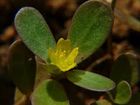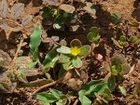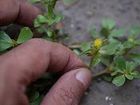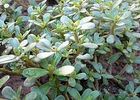Note: This is a project under development. The articles on this wiki are just being initiated and broadly incomplete. You can Help creating new pages.
Difference between revisions of "Portulaca oleracea - Purslane"
(→Photo Gallery) |
|||
| Line 48: | Line 48: | ||
==Photo Gallery== | ==Photo Gallery== | ||
<gallery class="left" caption="" widths="140px" heights="140px"> | <gallery class="left" caption="" widths="140px" heights="140px"> | ||
| − | + | Lunia5.jpg | |
| − | + | Lunia4.jpg | |
| − | + | Lunia2.jpg | |
| + | Lunia 3.jpg | ||
| + | Lunia1.jpg | ||
</gallery> | </gallery> | ||
Revision as of 09:38, 21 April 2018
Dudagorai or Portulaca oleracea (common purslane, also known as verdolaga, pigweed, little hogweed, red root, pursley) is an annual succulent in the family Portulacaceae, which may reach 40 centimetres (16 in) in height.Approximately forty cultivars are currently grown.
Contents
Uses
snake bites, boils, Snakebites, sores, Skin eruptions, pain from bee stings, bacillary dysentery, Diarrhea, hemorrhoids, postpartum bleeding, intestinal bleeding, cold, weak digestion.
Parts Used
Chemical Composition
Contains volatile oils, flavonoids, apigenin, luteolin, quercetin, kaempferol, tiliroside, triterpene glycosides including euscapic acid and tormentic acid, phenolic acids, and 3%–21% tannins.[1]
Common names
| Language | Common name |
|---|---|
| Kannada | Dudagorai, Doddagoni Soppu |
| Hindi | Khursa, Kulfa |
| Malayalam | |
| Tamil | |
| Telugu | boddupavilikoora, boddupavilikura |
| Marathi | NA |
| Gujarathi | NA |
| Punjabi | NA |
| Kashmiri | NA |
| Sanskrit | Loni, Lonika |
| English | Common Indian Parselane |
Habit
Identification
Leaf
| Kind | Shape | Feature |
|---|---|---|
| Simple | The leaves are divided into 3-6 toothed leaflets, with smaller leaflets in between |
Flower
| Type | Size | Color and composition | Stamen | More information |
|---|---|---|---|---|
| Unisexual | 2-4cm long | Yellow | 5-20 | Flowers Season is June - August |
Fruit
| Type | Size | Mass | Appearance | Seeds | More information |
|---|---|---|---|---|---|
| 7–10 mm (0.28–0.4 in.) long pome | clearly grooved lengthwise, Lowest hooked hairs aligned towards crown | With hooked hairs | {{{6}}} |
Other features
List of Ayurvedic medicine in which the herb is used
- Vishatinduka Taila as root juice extract
Where to get the saplings
Mode of Propagation
How to plant/cultivate
Easily grown in most soils[21][22], preferring a calcareous soil. Thrives in a dry lightly shaded position[16], though it prefers full sun. Plants usually self-sow quite freely when growing in a suitable position[19]. The seeds are contained in burrs that can easily attach themselves to clothing or animal's fur, thus transporting them to a new area where they can germinate and grow.The cultivar 'Sweet scented' is popular in France for making tea because the whole plant is sweet scented and the flowers have a spicy apricot-like fragrance[3]
Commonly seen growing in areas
Tall grasslands, meadows, Borders of forests and fields.
Photo Gallery
References
External Links
- Pages that are stubs
- Ayurvedic Herbs known to be helpful to treat snake bites
- Ayurvedic Herbs known to be helpful to treat boils
- Ayurvedic Herbs known to be helpful to treat Snakebites
- Ayurvedic Herbs known to be helpful to treat sores
- Ayurvedic Herbs known to be helpful to treat Skin eruptions
- Ayurvedic Herbs known to be helpful to treat pain from bee stings
- Ayurvedic Herbs known to be helpful to treat bacillary dysentery
- Ayurvedic Herbs known to be helpful to treat Diarrhea
- Ayurvedic Herbs known to be helpful to treat hemorrhoids
- Ayurvedic Herbs known to be helpful to treat postpartum bleeding
- Ayurvedic Herbs known to be helpful to treat intestinal bleeding
- Ayurvedic Herbs known to be helpful to treat cold
- Ayurvedic Herbs known to be helpful to treat weak digestion
- Herbs with Stem used in medicine
- Herbs with Leaves used in medicine
- Herbs with Flower used in medicine
- Herbs with common name in Kannada
- Herbs with common name in Hindi
- Herbs with common name in Telugu
- Herbs with common name in Sanskrit
- Herbs with common name in English
- Habit - Herb
- Index of Plants which can be propagated by Seeds
- Index of Plants which can be propagated by Cuttings
- Herbs that are commonly seen in the region of Tall grasslands
- Herbs that are commonly seen in the region of meadows
- Herbs that are commonly seen in the region of Borders of forests and fields
- Herbs





